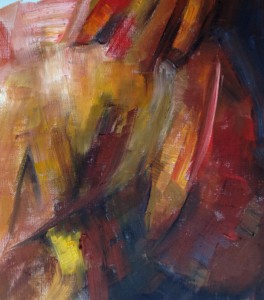From “Learning how to Learn from Masters: Module 3.3. Color in-depth”
In many paintings, colour is “broken” or “modulated” — a single colour area may consist of patches of different colors. In other words, the pigments are not (or not only) mixed on the palette to create the “right” colour — they are put on the canvas separately, with different brushstrokes, and their interactions happen “in the eye of the beholder” (to some extent, they also mix right there on the canvas).
If the painting you are studying happens to have such areas, and you aren’t experienced in this way of building colour, it makes sense to study it before you begin your final painting, to avoid unnecessary struggles afterwards (in the example example, I was studying the upper part of the prodigal son’s back.
 The idea of this study is very simple: please zoom in on such a complex area, take a sheet of canvas paper, and try to reproduce this area, studying it as an abstract object, without any regard to what it represents in the painting. It might not be easy, and you may experience frustration and resistance in the process. Try to “work through” it — not to surrender to it immediately; but if the resistance and frustration continue, it’s probably better to leave the exercise, and start afresh tomorrow.
The idea of this study is very simple: please zoom in on such a complex area, take a sheet of canvas paper, and try to reproduce this area, studying it as an abstract object, without any regard to what it represents in the painting. It might not be easy, and you may experience frustration and resistance in the process. Try to “work through” it — not to surrender to it immediately; but if the resistance and frustration continue, it’s probably better to leave the exercise, and start afresh tomorrow.
Apart from familiarizing yourself with how the colour is “built” in the masterpiece you are studying, this practice gives you in additional bonus: it helps to “switch off” the “normal” way of seeing (when you rather see the objects represented in the painting) and thus to see the painting as a plane filled with colour and brushstrokes.